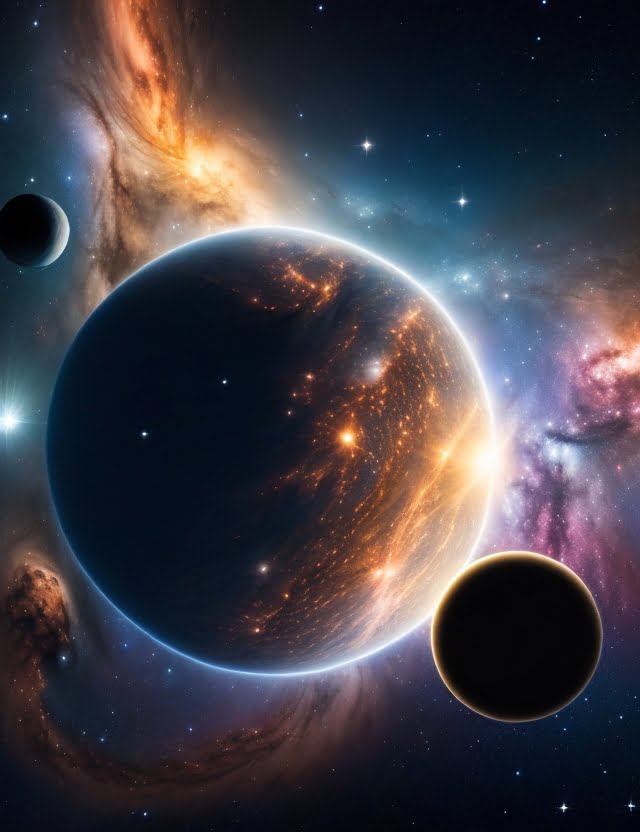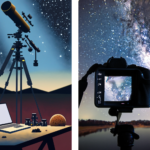Table of Contents
Have you ever asked yourself, What is the difference between astrophysics vs astronomy? I have, and I do confess to being a little confused.
While both astronomy and astrophysics explore the vast expanse of outer space and the cosmology of astronomical objects, they have distinct differences. Astrophysics delves into the theoretical aspects of celestial phenomena, whereas astronomy focuses on observation and data analysis in the sciences.
Physicists and scientists in the fields of astrophysics and astronomy work to ask and find answers to big questions about our existence. Examples like Galileo Galilei and Isaac Newton show how important theoretical astrophysics discoveries can be.
I once thought that these were the same things. Now I realise they are quite different.
My passion for astrophotography has sparked my interest in cosmology, celestial events, and the Earth. I watch videos on YouTube about astrophysics vs astronomy to help update my knowledge. Reading the latest space news online is a great way to stay informed during this fascinating time of discovery!
In this post, we’ll compare the fields of cosmology and astrophysics and look at how the work of an astronomer and an astrophysicist in outer space differs. We’ll also explore the similarities between them when studying celestial events and the concept of time.
I’m writing this post for you if you’re interested in understanding more about cosmology, or astrophysics vs astronomy. It should also be helpful for anyone wanting to become an astronomer or astrophysicist in the field of cosmology and time.
The basic difference: astrophysics vs astronomy

Astrophysics and astronomy are closely related fields that involve the study of celestial objects in the context of cosmology and time. However, there are basic differences that set them apart. Let’s check out what these are.
Astrophysics focuses on the physics behind celestial objects and phenomena
Astrophysics studies the physics of how the universe works, including cosmology and the phenomena occurring in the vast expanse of space and time. It involves applying principles of physics to understand how stars, galaxies, black holes, and other cosmic bodies function.
Astrophysicists use mathematical models to understand the behaviour, composition, and evolution of astronomical objects over time. They analyse the temperature, mass, luminosity, and electromagnetic radiation emitted by objects in space to gain more insights about these objects.
It seems to me that astrophysics is more than just physics in space and time. I’ve watched so many programs on TV about the universe and the concept of time. I’ve seen many of these scientists speculating and even talking about mysteries in a philosophical way, particularly those related to time. I love these discussions because space and time have always fascinated me, and I would guess many of you reading this right now would love answers to these questions beyond physics and time.
I’m talking here about the big questions we all want answers to. Are there aliens out there? Have they visited us in the past? What are UFOs? Are there other universes? What is time? It goes on and on…it appears to me that Astrophysics is so much bigger than astronomy. This is my opinion. What do you think?
Check this wonderful book out by the popular astrophysiscist Neil De Grasse Tyson:
Astronomy includes observing, studying, and classifying celestial objects
Astronomers spend time collecting data about stars, planets, asteroids, comets, nebulae, etc. They use telescopes and other instruments to collect this data. They spend time analyzing this to better understand these objects.
One of the main goals of astronomy is to classify celestial objects based on their characteristics, including their spectral type and shape or size. This classification helps astronomers organise their observations systematically and gain a better understanding of the diversity in our universe over time.
From my perspective, astronomy is primarily a scientific discipline that involves the study of celestial objects and phenomena. It focuses on understanding the universe and its various components. In my opinion, astronomy is more about detailed analysis and less about speculation. Additionally, it plays a crucial role in contributing to the field of astrophysics. The two fields are closely intertwined and rely on each other for advancements in knowledge and research.
Celestron 130 SLT telescope. Approx. $500*
Astrophysicists develop models to explain astronomical observations
Here are a few examples of models that astrophysicists use to study the concept of time.
- Einstein’s theory of general relativity is used to understand how gravity affects massive bodies like black holes over time.
- Quantum mechanics explains the behaviour of subatomic particles within stars.
These mathematical models allow astrophysicists to make predictions and test them. By comparing theoretical calculations with actual data, they can improve their understanding of the universe.
Roles and Responsibilities of Astrophysicists
There are many things that astrophysicists do. Their work includes:
- conducting research
- analyzing data
- proposing theories to explain the laws of physics in space
- testing these theories
Let’s look at each of these in a bit more detail.
Conducting research to understand the fundamental laws of physics in space
Astrophysicists are at the forefront of scientific exploration in space. They conduct extensive research to gain insights into the physical properties and phenomena occurring throughout the cosmos. By studying celestial bodies such as stars, planets, galaxies, and black holes, they strive to decipher how these entities interact with each other and their surrounding environment.
To accomplish this task, astrophysicists employ a wide range of observational techniques. They use powerful telescopes both on Earth and in space to capture images and collect data from distant regions of the universe. By examining different wavelengths of light emitted by celestial objects, they can discern valuable information about their composition, temperature, motion, and energy output.
I’ll get a small commission when you buy this. *Price may vary.
Analyzing data from telescopes, satellites, and other instruments
Once astrophysicists gather vast amounts of data through various instruments like telescopes or satellites, their next responsibility is meticulously analyzing this wealth of information. They employ advanced mathematical and statistical methods to extract meaningful patterns and correlations from complex datasets.
By scrutinizing these datasets for anomalies or deviations from expected behaviour, astrophysicists can identify unique phenomena that challenge existing theories or provide new insights into cosmic processes. This analysis often involves sophisticated computer modelling techniques that simulate astronomical events or replicate conditions within stars or galaxies.
One of the newest tools that astrophysicists are using is the largest and most expensive space telescope ever built, the James Webb Telescope. I’ve tried to stay up-to-date with the latest news and discoveries that this telescope is helping to make. It is doing its job, I suppose, because already it has challenged what we thought we knew about the universe. Just yesterday, I heard about a claim that the age of the universe should be extended by billions of years. It seems that we didn’t know as much as we thought. That’s cutting-edge science for you, I guess!
Developing theories and models to explain cosmic phenomena
One of the most significant responsibilities of an astrophysicist is developing theories and models that offer explanations for cosmic phenomena. These theoretical models help scientists make sense of interactions between matter, radiation, gravity, and other fundamental forces.
The models that astrophysicists develop are based on known physical laws and principles, but they also include new hypotheses to account for unexplained phenomena. By refining these theories through experimentation and observation, astrophysicists continually push the boundaries of our understanding of the universe.
Where astrophysicists work
Astrophysicists normally work in a research laboratory, classroom, or observatory. Most work for a university or college. Planetariums sometimes employ astrophysicists, and others work for government agencies such as NASA or the military.
Roles and Responsibilities of Astronomers
Astronomers also try to unravel the mysteries of the universe. They observe celestial objects using telescopes or instruments in space, collect data on stars, galaxies, planets, and other cosmic objects, and study their properties, composition, and behaviour.
Through careful observation and analysis, they can determine the distance between celestial bodies, identify patterns in their movements, and even detect previously unknown phenomena.
Collecting data is another vital aspect of an astronomer’s role. This data includes various measurements such as brightness levels, spectral characteristics, temperature readings, and chemical compositions. Astronomers can draw meaningful conclusions about the nature of the universe and the objects within it.
Astronomers investigate stellar evolution to comprehend how stars are born from clouds of gas and dust while also exploring how they eventually meet their end in supernova explosions or collapse into black holes. Similarly, they study galaxies to understand how they form and investigate the mysteries surrounding the dark matter that appears to hold them together.
Analytical thinking is crucial for interpreting complex datasets obtained through observations or simulations. Mathematical proficiency enables them to develop models that explain observed phenomena accurately. Computer programming skills aid in processing large amounts of data and running simulations to test theoretical predictions.
Astronomers often collaborate with colleagues across the globe, sharing their findings. This collaboration creates a vibrant scientific community that drives progress in astrophysics. By exchanging ideas, challenging assumptions, and collectively analyzing data, astronomers push the boundaries of our knowledge further.
Where astronomers work
Astronomers work in observatories, labs, universities, and government agencies. They may teach or work as researchers. Many spend most of their time researching and analyzing data. Others work as writers for science publications.
Comparison of astrophysics vs astronomy
In other words, there is a certain overlap in the work of astrophysics vs astronomy. In my experience, astrophysics is more theoretical, while astronomy does more of the heavy lifting (number crunching and analysis of data) to provide the astrophysicists with more questions to answer.
Focus on theoretical aspects vs. observation
Astrophysicists, as the name suggests, primarily focus on the physics behind celestial objects and phenomena.
On the other hand, astronomers primarily observe celestial objects using telescopes and other instruments. They collect data from various wavelengths of light emitted by stars and galaxies to analyze their properties. Astronomers spend countless hours observing celestial events like supernova explosions or planetary transits to gather valuable information about our universe.
Collaboration for a comprehensive understanding
While astrophysicists delve into theoretical aspects and astronomers focus on observations, the collaboration between these two disciplines is crucial for a comprehensive understanding of the cosmos. Astrophysicists rely on observational data collected by astronomers to test their theories and refine their models. Conversely, astronomers seek insights from astrophysicists to interpret complex observations accurately.
This collaboration allows both disciplines to complement each other’s work effectively. Here is a nice example of how this collaboration works:
- Astrophysicists might develop a theory explaining how stars evolve based on calculations involving nuclear fusion processes.
- Astronomers can then observe specific star clusters or galaxies to verify if these predictions align with real-world observations.
- If discrepancies arise between theory and observation, astrophysicists can revise their models accordingly.
Increasing our knowledge of the universe
Both astrophysicists and astronomers have made it possible to understand more about the universe. Their collective efforts have led to groundbreaking discoveries and advancements in our understanding of cosmic phenomena.
Astrophysicists contribute by:
- Investigating the origins of the universe, studying topics like the Big Bang theory.
- Exploring the nature of dark matter and dark energy, which constitute a significant portion of the cosmos.
- Modelling stellar evolution and understanding how stars form, live, and die.
Astronomers contribute by:
- Identifying exoplanets orbiting distant stars that potentially harbour conditions suitable for life
- Studying galaxies to understand their formation, structure, and interactions
- Detecting and analyzing celestial events such as supernovae or gamma-ray bursts
Distinctions between astrophysics, astronomy, and cosmology
Astrophysics is a branch of science that delves into the physical properties and characteristics of celestial objects using principles derived from physics. It focuses on understanding the fundamental processes that govern the behaviour of stars, galaxies, and other cosmic entities.
Astronomy, on the other hand, encompasses the observation-based study of various celestial bodies. Astronomers gain insights into the vastness and complexity of our universe.
In contrast to both astrophysics vs astronomy, cosmology takes a broader perspective by exploring the origin, evolution, structure, and ultimate fate of the entire universe.
Cosmologists draw upon both astrophysical theories and astronomical observations to develop comprehensive explanations for the workings of our universe.
Exploring the field of cosmology
Cosmology, a branch of astrophysics that delves into the study of the universe, encompasses a wide range of intriguing phenomena and celestial events. By examining large-scale structures such as galaxy clusters or cosmic microwave background radiation, scientists gain valuable insights into the mysteries of our vast cosmos.
Galaxies, those magnificent collections of stars, gas, and dust scattered throughout outer space, are at the heart of cosmological research. Scientists employ powerful telescopes to observe these celestial objects to understand their formation and evolution. By studying galaxies across different epochs, researchers can trace the intricate story behind their birth and growth over billions of years.
One crucial aspect that cosmologists investigate is dark matter and dark energy. These elusive entities have a significant influence on cosmic expansion. Dark matter exerts gravitational forces that hold galaxies together, while dark energy pushes them apart at an accelerating rate. Understanding these enigmatic components is vital for comprehending how our universe evolves.
Theories play a central role in shaping our understanding of cosmology. The Big Bang theory stands as one such cornerstone concept in this field. According to this theory, our universe originated in an incredibly hot and dense state approximately 13.8 billion years ago. As time progressed, it expanded rapidly and continues to expand even today. Through meticulous observations and mathematical modelling, scientists have gathered substantial evidence supporting this widely accepted theory.
To comprehend the grandeur of the cosmos on such a vast scale, one must embrace concepts from various scientific disciplines, including physics and astronomy. For instance, general relativity plays a pivotal role in explaining how gravity shapes the behaviour of celestial bodies within our solar system as well as on larger scales throughout the entire universe.
Furthermore, advancements in nuclear physics allow us to understand processes occurring within stars, such as nuclear fusion, which powers these celestial objects. By studying the behaviour of matter and energy under extreme conditions, scientists can unravel the intricate mechanisms that govern the birth, life, and death of stars.
In recent years, cosmologists have also detected gravitational waves. These ripples in spacetime provide a new opportunity to observe cosmic events such as colliding black holes or neutron stars. By detecting and analyzing these gravitational waves, scientists gain valuable insights into the nature of gravity itself. By detecting and analyzing these gravitational waves, scientists gain valuable insights into the nature of gravity itself and uncover hidden aspects of our universe.
Conclusion
Although there are differences between astrophysics vs astronomy, and cosmology, these fields often overlap.
To further explore these fascinating areas of research, individuals interested in astronomy or astrophysics can consider pursuing higher education in related disciplines or engaging in amateur stargazing activities. Staying updated with scientific advancements through books, documentaries, or online resources can provide valuable insights into this ever-evolving field.
By embracing curiosity about our place in the cosmos and supporting scientific endeavours that push boundaries, we contribute to advancing our understanding of the universe.








